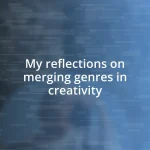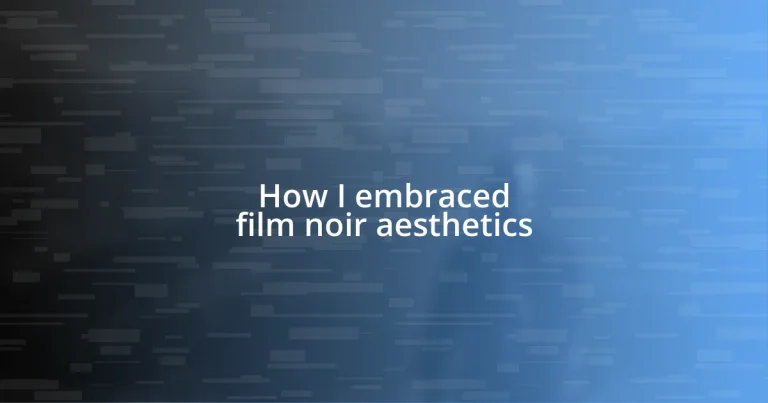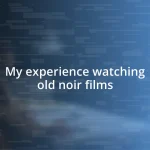Key takeaways:
- Film noir aesthetics rely heavily on chiaroscuro lighting, character complexity, and unexpected plot twists to create emotional tension and moral ambiguity.
- Cinematography techniques like low-angle shots, oblique angles, and selective focus are crucial for enhancing the storytelling and depicting character struggles.
- Dialogue and narration play vital roles in building atmosphere and developing character complexities, with pacing being key to maintaining audience engagement.
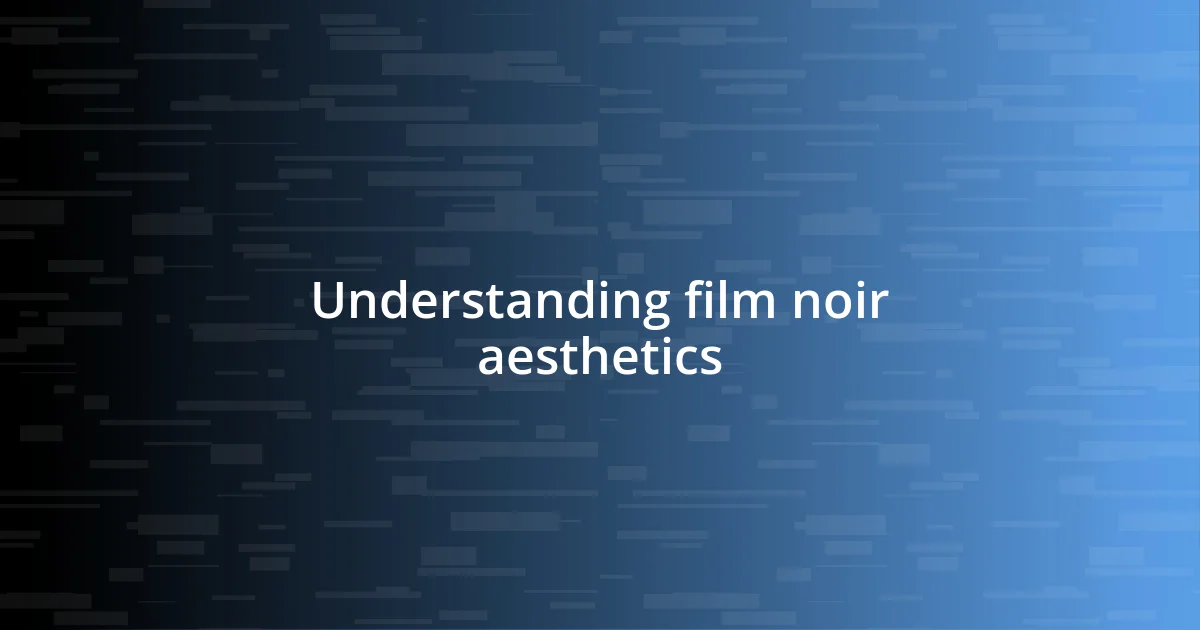
Understanding film noir aesthetics
Understanding film noir aesthetics is like stepping into a shadowy world where light and darkness dance together in a powerful embrace. The stark contrasts seen in noir films—think deep shadows and bright highlights—create a palpable tension that pulls you in, inviting you to explore the depths of human emotion. I often find myself captivated by how these visual choices reflect the characters’ internal struggles, raising questions like, “What secrets lie hidden within the darkness?”
Color plays a surprisingly understated role in film noir. While the genre is often associated with black and white, the use of subtle color palettes in modern interpretations can evoke a similar disquiet. I remember watching a contemporary noir film that employed muted tones to create an atmosphere of despair and isolation. It made me realize how color—or the lack thereof—can enhance the storytelling, leaving viewers feeling a certain way without a single line of dialogue.
The settings in film noir are crucial to its aesthetics, often featuring gritty urban environments shrouded in mystery. I’ve walked through cities late at night and felt that same eerie ambiance that noir films capture so well. It’s almost like these locations become characters themselves, leading me to ponder: how much does our surroundings influence the story we’re drawn into? Ultimately, film noir aesthetics merge visuals and emotions, creating a rich tapestry that resonates with the viewer in ways that linger long after the credits roll.
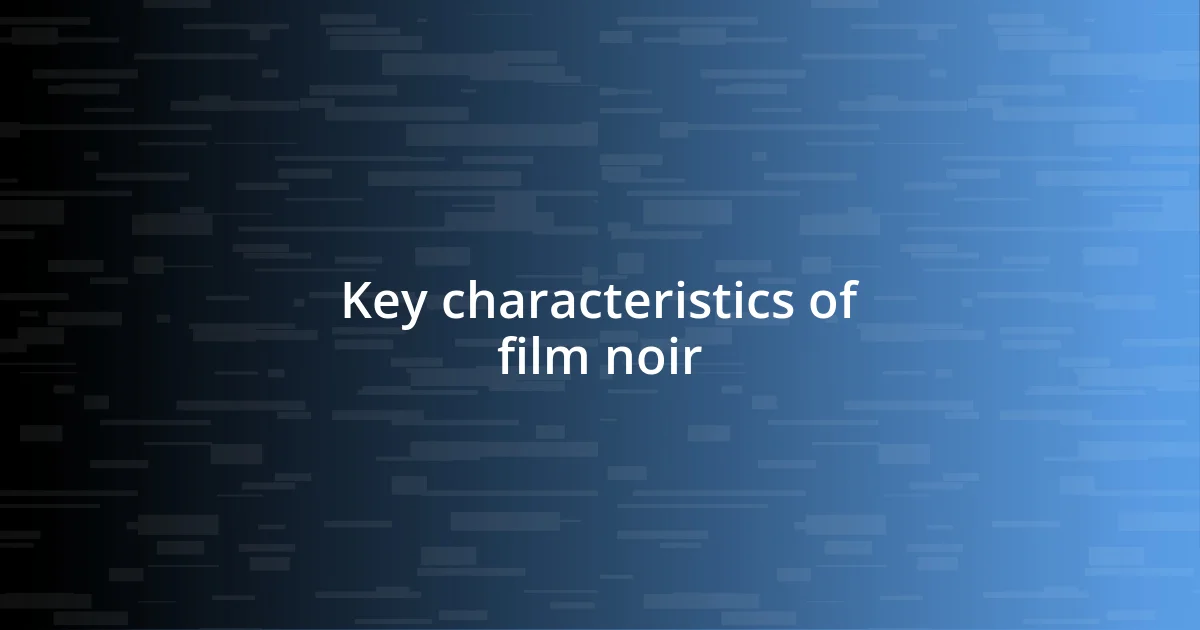
Key characteristics of film noir
The key characteristics of film noir revolve around its unique style and thematic elements. One of the hallmarks is its use of chiaroscuro lighting, which creates dramatic contrast between light and shadow. I still recall the feeling of watching a classic noir film, where the play of light not only illuminates a character’s face but also casts ominous shadows, hinting at moral ambiguity. This technique pulls the audience into a world of tension and intrigue, where every gaze and movement is loaded with meaning.
Characterization is equally essential in film noir. The protagonists, often anti-heroes, grapple with their flawed natures and moral dilemmas. I remember being struck by a film’s lead, who navigated a shady world fraught with betrayal and corruption. It made me reflect on the complexities of human nature—how we all possess a light and a shadow within us, and how that duality can drive us to make questionable choices.
Furthermore, plot twists and a sense of fatalism permeate the storylines of noir films. I’ve found it fascinating how discussions about destiny and choice emerge, especially during those unexpected plot turns that lead to inevitable downfalls. This sense of impending doom keeps you guessing—much like life itself, where sometimes we’re not sure who will emerge unscathed.
| Characteristic | Description |
|---|---|
| Chiaroscuro Lighting | Creates dramatic contrasts between light and shadow, enhancing emotional tension. |
| Characterization | Features complex anti-heroes struggling with moral dilemmas. |
| Plot Twists | Incorporates unexpected turns, evoking themes of fatalism and choice. |
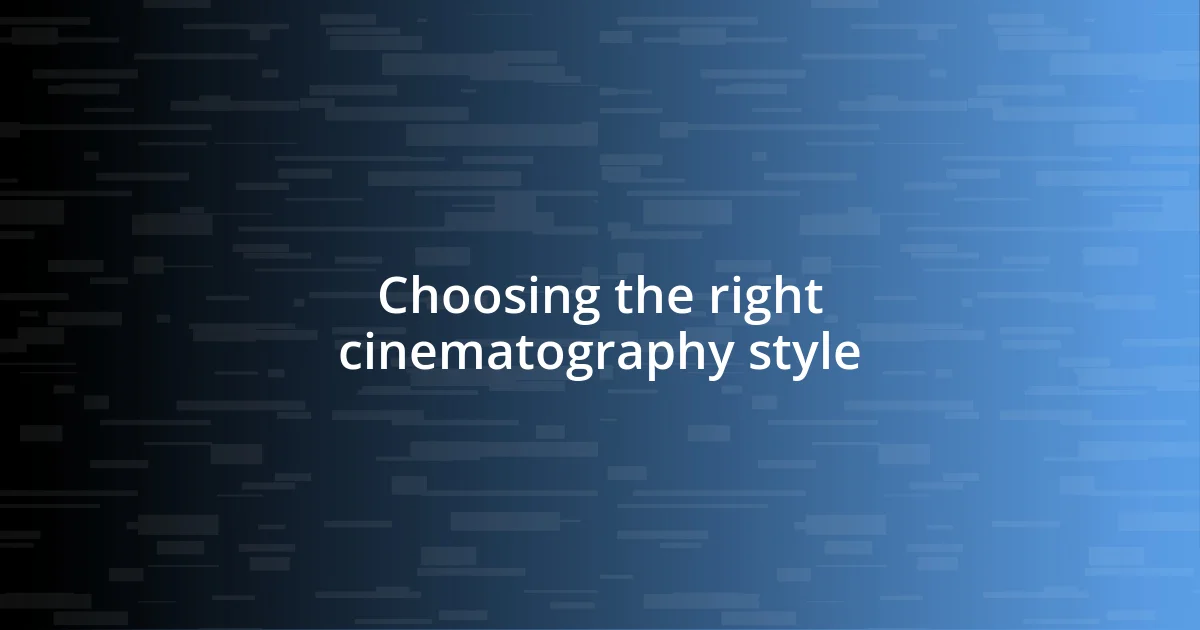
Choosing the right cinematography style
Choosing the right cinematography style in film noir is crucial to evoking the desired atmosphere. I remember spending hours studying various cinematographic techniques, feeling like a detective searching for clues in the visual tapestry. High-contrast lighting, typically achieved through chiaroscuro, often plays a key role in emphasizing emotional turmoil and moral ambiguity. These choices can transform an ordinary scene into one that resonates deeply, whispering secrets of the characters’ inner conflicts.
When considering cinematography for a noir project, think about these essential elements:
- Low-Angle Shots: They create a sense of power or menace, often making characters appear larger-than-life, underscoring their moral complexities.
- Oblique Angles: These shots can evoke unease, mirroring characters’ internal struggles and the chaotic world around them.
- Selective Focus: By blurring the background, focus is drawn to critical elements of a scene, heightening emotions and tension.
Integrating these techniques into your film helps to craft a visual language that speaks to the heart of noir. I once experimented with low-angle shots during a project, and the response was electrifying—viewers felt both intimidated and intrigued, drawn into the shadows of the narrative. It reassured me that every choice in cinematography carries weight and meaning, shaping how the audience perceives the story unfolding before them.
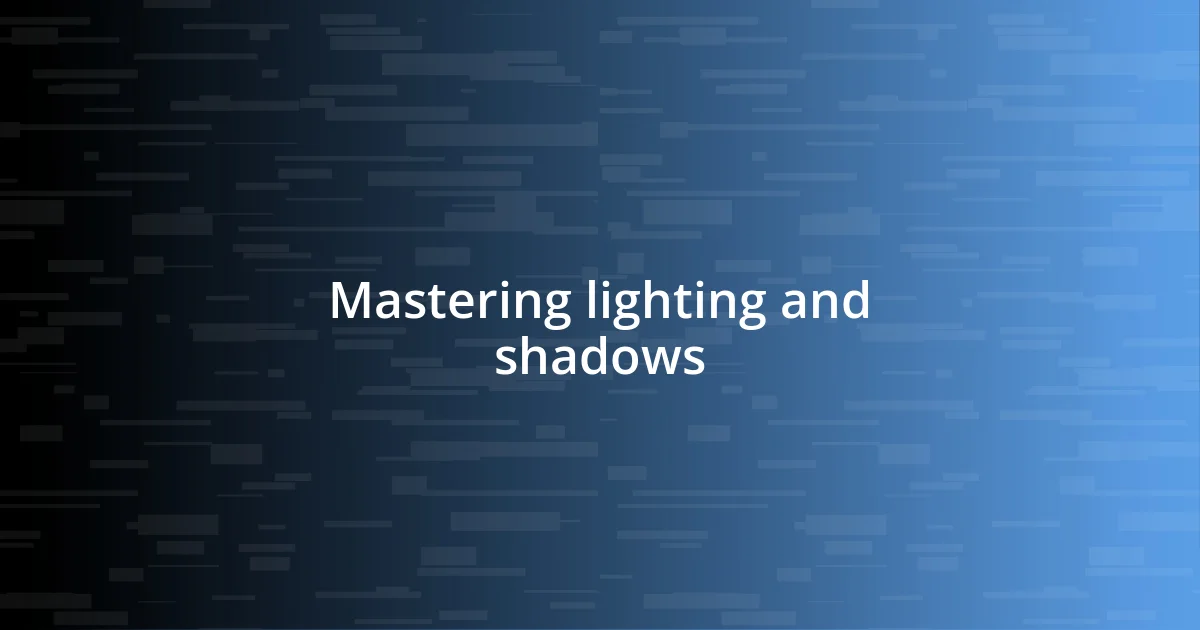
Mastering lighting and shadows
Mastering light and shadow in film noir can truly elevate the storytelling. I remember when I first experimented with lighting for a short film project. I set up a single source of light—an overhead lamp—and watched in awe as shadows danced across the walls, transforming an ordinary room into a realm of suspense and intrigue. There’s something almost magical about how a simple setup can evoke such rich emotion. How many times have you felt an adrenaline rush just from the way a character is lit, with shadows hinting at hidden intentions?
In my experience, shadows serve more than just aesthetic purposes; they embody the themes and complexities of the characters. One particular scene stands out in my memory: a dimly lit bar where the light highlighted a character’s troubled expression, while the shadows hinted at the betrayals lurking just out of frame. It’s as if the lighting itself communicates the underlying tension. I often ask myself, what stories are hidden in the shadows we cast?
Furthermore, the art of managing shadows can change how viewers interpret a scene. I vividly recall a late-night shoot where we played with backlighting. The result was chilling—characters almost appeared ghostly, their faces revealed only by unexpected flickers of light. I realized then that shadows are often the unsung heroes of film noir, revealing truths lurking just beneath the surface. Each decision about lighting shapes the viewer’s perception, making them key players in the unfolding drama. Wouldn’t you agree that this interplay between light and shadow is what truly captures the essence of noir?
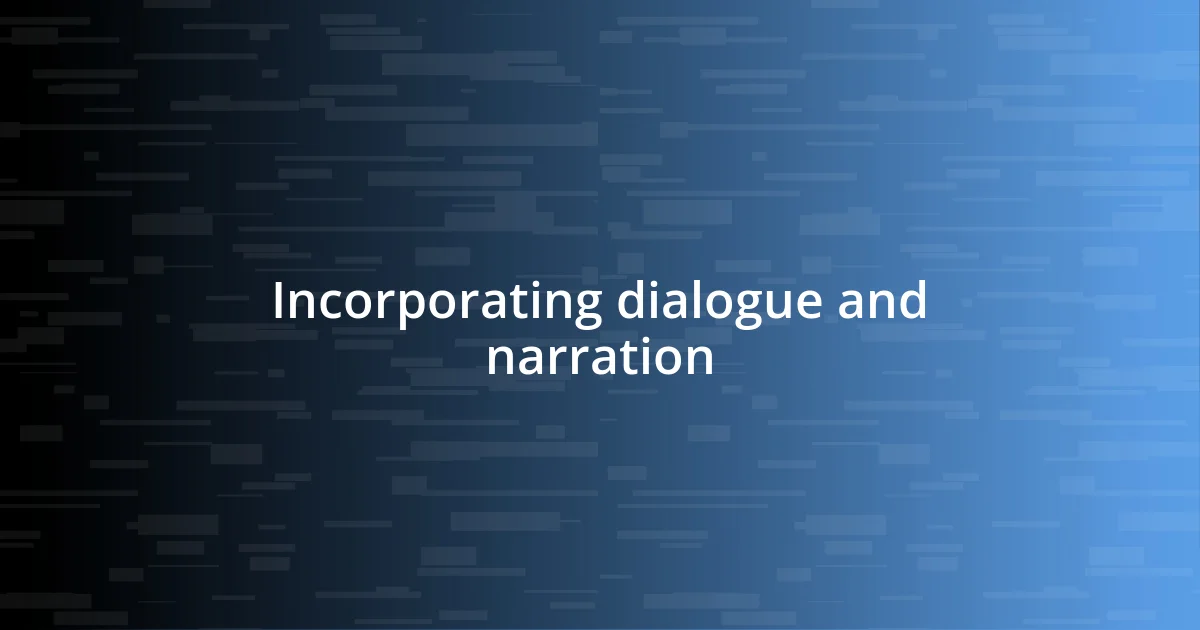
Incorporating dialogue and narration
Incorporating dialogue in a film noir project is essential to building atmosphere and character development. I recall when I crafted a tense scene, carefully choosing each word to reflect the underlying mistrust. The characters exchanged quick, sharp lines that felt loaded with meaning. Wasn’t it thrilling to see how just a simple phrase could unveil so much about their motives and fears? I often think about how dialogue in noir doesn’t just tell a story—it creates an emotional climate, drawing viewers into a world filled with intrigue.
When it comes to narration, I find first-person perspectives to be particularly powerful in film noir. I remember experimenting with a voiceover in my own work, which allowed me to dive deep into a character’s psyche. Hearing their thoughts provided a peek behind the curtain, revealing fears and desires that visuals alone couldn’t convey. It’s fascinating how a well-placed narrative voice can shift the viewer’s understanding, providing context for seemingly ambiguous scenes. Have you ever found yourself feeling a connection to a character by simply hearing their inner thoughts?
Last but certainly not least, I believe the rhythm of dialogue should mirror the tensions present in the plot. I once directed a scene where the characters spoke over each other—each trying to outwit the other. It was exhilarating! The chaos on screen reflected the stakes of the moment, reinforcing the feeling that no one is safe in this world. This frenetic exchange challenged viewers to keep up with the action, while also immersing them in the noir’s pulse. Dialogue, when leveraged correctly, not only advances the plot but immerses the audience in the emotional turmoil of the characters. Wouldn’t you agree that it’s this intricate dance of words that truly encapsulates the essence of noir?
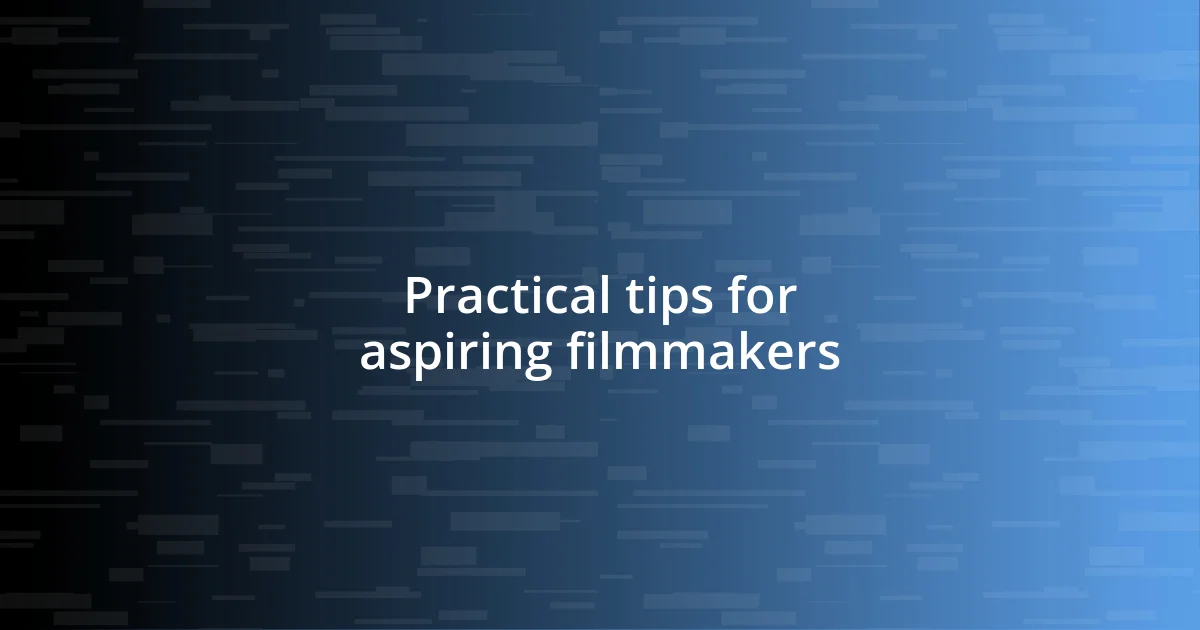
Practical tips for aspiring filmmakers
When diving into film noir, focus on crafting an immersive world that feels authentic. I remember my first attempt at establishing a noir atmosphere through set design. I searched for vintage props that resonated with the genre’s signature style—a flickering neon sign and an old record player brought everything to life. Have you considered how the smallest details can transport your audience to another era? The energy in the room shifted, and it made me realize how essential those visual cues are in establishing tone.
Another practical tip is to embrace the aesthetic in your costumes. I once worked on a project where we clothed our characters in sharp suits and elegant dresses, evoking a sense of elegance. It was astounding how the right attire could instantly change the viewer’s perception, hinting at the characters’ backgrounds and personalities. Have you ever found yourself judging a character solely based on their wardrobe? Paying attention to costumes can deepen the narrative, enhancing the emotional journey.
Lastly, I can’t stress enough the importance of pacing in film noir. I once edited a sequence where scenes flowed in quick succession—each cut punctuated the tension and left viewers on the edge of their seats. The thrill of that rapid-fire pacing made it feel like a rollercoaster ride. How important do you think rhythm is in holding your audience’s attention? As aspiring filmmakers, mastering pacing can be your secret weapon in keeping viewers engaged and eager for what comes next.










